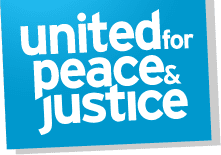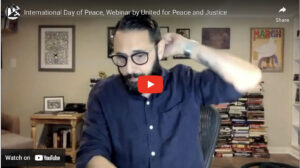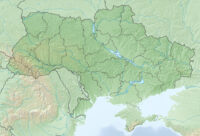The Nuclear Weapons Ban Treaty
John Burroughs
Executive Director of the Lawyers Committee on Nuclear Policy
UFPJ Briefing Call, September 18, 2017
On July 7, 2017, a UN conference adopted the Treaty on the Prohibition of Nuclear Weapons by a vote of 122 to 1 (Netherlands), with one abstention (Singapore). A signing ceremony will be held Wednesday, September 20, at the United Nations. The treaty will enter into force – become legally effective for its members – when 50 states have signed and ratified. This could happen in one to two years.
All nine nuclear-armed states did not participate in the negotiations – US, UK, France, Russia, China, India, Pakistan, North Korea, and Israel. Most countries in NATO or other nuclear weapons alliances with the United States also did not participate. It is considered unlikely that nuclear-armed states will join the treaty in the near term. As to nuclear allies, the picture is somewhat unclear; what they do will depend in part on campaigning in their countries. It is possible for a country to sign the treaty but delay ratification. Signature imposes an obligation to act consistently with the object and purpose of the treaty. If a country renounced all participation in nuclear weapons activities, they could say they were acting in accordance with the object and purpose even if they remained in an alliance with the United States or other nuclear-armed state. But the question is complicated.
The nuclear weapons ban treaty effort grew out of governmental onferences on the humanitarian consequences of nuclear explosions held in 2013 and 2014 in Oslo; Nayarit, Mexico; and Vienna. It has deeper roots in the formation of regional nuclear weapon free zones, starting with the 1967 Treaty of Tlatelolco establishing such a zone in Latin America and the Caribbean; in General Assembly resolutions, notably resolution 1653 of 1961, in which a sharply divided Assembly declared the use of nuclear weapons to violate the UN Charter and other international law; the General Assembly’s request to the International Court of Justice for an advisory opinion on the legality of threat or use of nuclear weapons; and in persistent efforts by non-nuclear weapon states in Nuclear Non-Proliferation Treaty review meetings to extract a commitment from the nuclear weapon states to commence a concrete process of negotiating disarmament.
With the nuclear weapons ban treaty, countries largely of the nuclear-weapon-free Global South, joined by Austria and Ireland, escalated the struggle, declaring that nuclear weapons must be legally prohibited and eliminated as has been done with biological weapons, chemical weapons, landmines, and cluster munitions.
Elements
The nuclear weapons ban treaty prohibits the development, testing, possession, and use and threatened use of nuclear weapons, and also bars assistance in any way with prohibited acts.
It also requires states parties in a position to do so to assist affected states with assistance to victims of nuclear testing and use, and with environmental remediation of contaminated areas.
And it provides two pathways for nuclear-armed states to verifiably and irreversibly dismantle their nuclear arsenals, prior to joining the treaty or after doing so. The treaty also generally provides that measures for verified and irreversible elimination of nuclear weapons may be addressed at meetings of states parties. Non-states parties may attend meetings. So other approaches could be created for nuclear-armed states to disarm.
Significance
Development, testing, and possession of nuclear weapons are already prohibited for most states by the NPT.
However, there is no treaty prohibition of use and threatened use that is universal in aspiration, so this is a new element of the ban treaty. Moreover, it could affect policies of nuclear allies that want to join the treaty. And of course of nuclear-armed states if they did so.
The obligations regarding victim assistance and environmental remediation are new. Hopefully they will give impetus to progress in these areas.
The options for nuclear-armed states to disarm and join the treaty are new. While somewhat vague, they have the essential elements of verification and irreversibility, subject to oversight by an agency to be named later! So there’s enough flexibility there to accommodate nuclear-armed states that truly want to disarm.
From the perspective of LCNP and IALANA, a great contribution of the nuclear weapons ban treaty is that it recognizes, reinforces, and solidifies existing international law applicable to all states whether or not they join the treaty. A real resource for advocacy.
Why do I say this? As to law, the preamble sets out principles applicable to all states:
• Reaffirms the need for all states at all times to comply with international humanitarian law and international human rights law;
• Identifies key principles and rules of international humanitarian law, including the rule of distinction between civilians and combatants and civilian objects and military objectives; the prohibition of indiscriminate attacks; the rule of proportionality; the rule of precaution; the prohibition of infliction of unnecessary suffering; and the rules for the protection of the environment;
• Considers that any use of nuclear weapons would be contrary to the rules of international law applicable in armed conflict, in particular the principles and rules of international humanitarian law;
• Recalls the UN Charter prohibition of the threat or use of force;
• Reaffirms the obligation to pursue in good faith and bring to a conclusion negotiations leading to nuclear disarmament in all its aspects under strict and effective international control. That obligation was set forth in a unanimous conclusion of the International Court of Justice in its 1996 Advisory Opinion, based on Article VI of the Nuclear Non-Proliferation Treaty and UN practice going back to the very first General Assembly resolution, in 1946.
Furthermore, we believe that prohibitions of using and threatening to use nuclear weapons, apply to all states whether or not they are party to the treaty, as a matter of universal law rooted in international humanitarian law, the UN Charter, and principles of humanity and dictates of public conscience.
Let me emphasize the importance of the explicit inclusion of the prohibition of threatened use in the treaty. Threat is central to now decades-old reliance on nuclear weapons in military and security postures. The prohibition of threatened use will be an important tool in the ongoing campaign to delegitimize ‘nuclear deterrence’ as contrary to international law as well as common sense in view of the immense risks involved. Delegitimization of nuclear deterrence is essential to success in achieving the global abolition of nuclear arms.
Finally, something about process. The nuclear weapons ban treaty is the product of a participatory, conscience-driven and non-discriminatory movement of states taking responsibility for the future of humanity working together with civil society. Taking an optimistic point of view, it is a harbinger of the democratization of disarmament and of the United Nations, and of a paradigm shift toward human security, placing the individual at the center rather than considerations guided only by states’ interests.
The United States
What does all of this mean for advocacy and organizing in the United States? I am tempted to leave that question, which is a tough one, for Jackie. But let me say a couple of things.
The nuclear weapons ban treaty lays down a marker, a challenge. Unlike the NPT, it sets out with crystal clarity the goal of eliminating nuclear weapons and the humanitarian reasons for the goal. As I have explained, it affirms and specifies existing international law applying to all states and therefore the United States.
It would be possible to take the position that the United States should support and initiate disarmament negotiations among some or all nuclear-armed states that would enable them to join the ban treaty. And probably that’s fine as an advocacy position. But we should keep in mind that future nuclear disarmament might not take place in the context of the nuclear ban treaty – yet nuclear disarmament is still desirable and needed. So far as North Korea’s nuclear weapons program, the nuclear ban treaty does not seem very relevant for now. But it certainly supports the position that regional and global denuclearization should be the goal.


